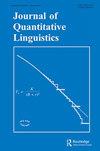基于困惑度的三种语言间长期语言距离测量方法
IF 1.7
2区 文学
0 LANGUAGE & LINGUISTICS
引用次数: 4
摘要
摘要本文的目的是应用一种基于语料库的方法,基于困惑度的测量,自动计算三种语言历史时期之间的跨语言距离。这三个历史语料库是在小说和非小说的平衡基础上,以最接近原作的拼写构建和收集的。从中世纪到20世纪末,这种方法已被应用于测量加利西亚语与葡萄牙语和西班牙语在原始拼写和自动转录拼写方面的历史距离。定量结果与从历史语言学专家那里提取的假设进行了对比。结果表明,加利西亚语和葡萄牙语在中世纪是同一语言的变体,而加利西亚语自19世纪末以来与葡萄牙语和西班牙语融合和分化。在这个过程中,正字法起着相关的作用。需要指出的是,该方法是无监督的,可以应用于其他语言。本文章由计算机程序翻译,如有差异,请以英文原文为准。
A Methodology to Measure the Diachronic Language Distance between Three Languages Based on Perplexity
ABSTRACT The aim of this paper is to apply a corpus-based methodology, based on the measure of perplexity, to automatically calculate the cross-lingual language distance between historical periods of three languages. The three historical corpora have been constructed and collected with the closest spelling to the original on a balanced basis of fiction and non-fiction. This methodology has been applied to measure the historical distance of Galician with respect to Portuguese and Spanish, from the Middle Ages to the end of the 20th century, both in original spelling and automatically transcribed spelling. The quantitative results are contrasted with hypotheses extracted from experts in historical linguistics. Results show that Galician and Portuguese are varieties of the same language in the Middle Ages and that Galician converges and diverges with Portuguese and Spanish since the last period of the 19th century. In this process, orthography plays a relevant role. It should be pointed out that the method is unsupervised and can be applied to other languages.
求助全文
通过发布文献求助,成功后即可免费获取论文全文。
去求助
来源期刊

Journal of Quantitative Linguistics
Multiple-
CiteScore
2.90
自引率
7.10%
发文量
7
期刊介绍:
The Journal of Quantitative Linguistics is an international forum for the publication and discussion of research on the quantitative characteristics of language and text in an exact mathematical form. This approach, which is of growing interest, opens up important and exciting theoretical perspectives, as well as solutions for a wide range of practical problems such as machine learning or statistical parsing, by introducing into linguistics the methods and models of advanced scientific disciplines such as the natural sciences, economics, and psychology.
 求助内容:
求助内容: 应助结果提醒方式:
应助结果提醒方式:


